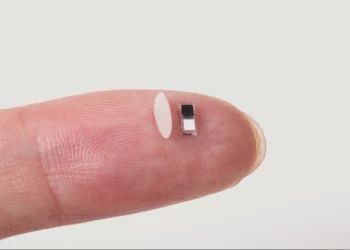
Our eyes cannot see infrared light, but that’s why we have infrared detectors, acting like an augmented sense. However, these aren’t too sensitive since infrared light carries so little energy compared to ambient heat, resulting in a lot of noise. The best infrared detectors overcome this problem by operating at ultra-low temperatures, but this requires a lot of energy and can be extremely expensive.
An international team of researchers has streamlined infrared detection by developing a low-cost device that coaxes molecules to convert invisible infrared into visible light. The molecules absorb mid-infrared light inside their vibrating chemical bonds, then transfer this extra energy to visible light they encounter. In the process, the infrared light is ‘upconverted’ to broadband closer to the blue end of the spectrum, which is visible to modern cameras.
Converting light frequencies is no trivial task due to constraints owed to the law of energy conservation. But the researchers found a workaround by adding energy to infrared light using a mediator, namely tiny vibrating molecules.
The main challenge lies in having the molecules intersect with the visible light quickly enough for the energy transfer to occur. To do so, the team led by researchers at the University of Cambridge devised a setup that traps light from a laser into crevices surrounded by a thin layer of gold. A single layer of molecules occupies the same tiny volume where light is squeezed through a space a billion times smaller than a human hair.
“Trapping these different colors of light at the same time was hard, but we wanted to find a way that wouldn’t be expensive and could easily produce practical devices,” said co-author Dr. Rohit Chikkaraddy from the Cavendish Laboratory, who devised the experiments based on his simulations of light in these building blocks.
“It’s like listening to slow-rippling earthquake waves by colliding them with a violin string to get a high whistle that’s easy to hear, and without breaking the violin,” said Professor Jeremy Baumberg, who led the research.
What truly makes this new infrared detector useful is that it can be integrated into existing visible light detecting technologies, such as ordinary cameras.
Low-cost infrared detectors have a wide range of applications, ranging from sensing contaminants and tracking cancers to observing galactic structures. And while this prototype is still in its early phases of development, the researchers are confident they can optimize its performance even further to turn it into a cheap sensor for industry and scientific applications.
“So far, however, the device’s light-conversion efficiency is still very low,” cautions Dr. Wen Chen, first author of the work. “We are now focusing our efforts in further improving it” – a key step toward commercial applications.
The findings appeared in the journal Science.




